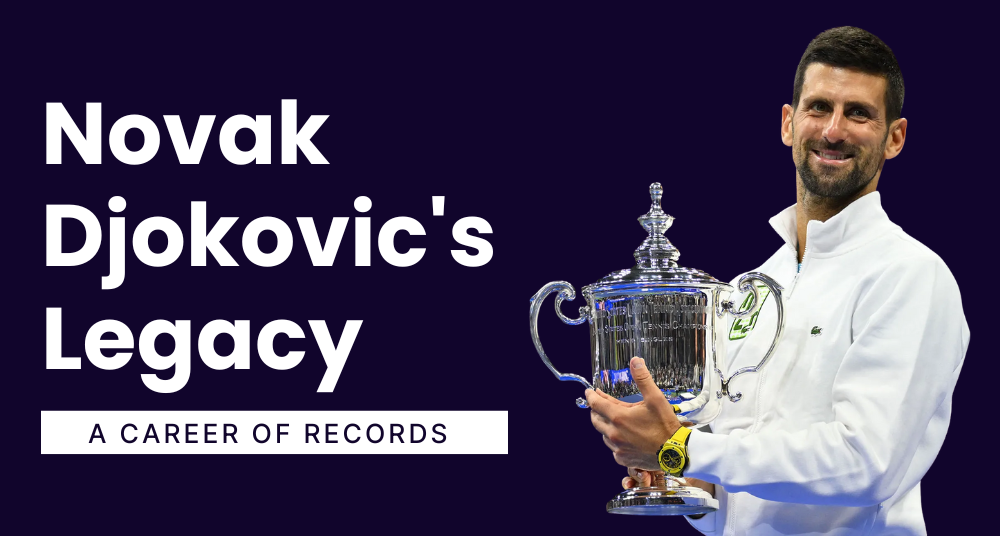When discussing tennis legends, three names almost always dominate the conversation: Roger Federer, Rafael Nadal, and Novak Djokovic. Collectively known as the Big Three, their rivalries, records, and reigns have defined modern men’s tennis. But in recent years especially, arguments increasingly tilt toward Djokovic as possibly the greatest male tennis player ever. Does he deserve that title? What makes his case strong — and where are the counterpoints? In this article we’ll explore Novak Djokovic’s achievements, records, rivalries, and intangible factors to assess whether he can be called the GOAT (Greatest of All Time).
Early Years & Rise to Prominence
Novak Djokovic was born on May 22, 1987, in Belgrade, Serbia. His early years were marked by the typical mix of raw talent and hard work. He rose steadily through the junior circuit and made his first impact as a professional in the mid-2000s. Some key moments of his early growth:
- First major breakthrough: His first Grand Slam title came in 2008 at the Australian Open, where he defeated Jo-Wilfried Tsonga in the final.
- From there, he developed a reputation for mental strength, endurance, resilience, and superb defense—traits that would come to define much of his play and his edge in tight matches.
These years set the foundation: physical fitness, adaptability (on all surfaces), and a belief (from himself and others) that he could compete at the very top, not just against older legends, but as a peer to them.
Novak Djokovic’s Major Achievements and Records
To understand Novak Djokovic’s claim, you must first look at the sheer numbers — the trophies, the records, the statistical dominance. Djokovic holds many of men’s tennis’ top records. Some of his standout achievements:
- Djokovic has won 24 men’s singles Grand Slam titles, more than any other male player.
- Breakdown by major:
- Australian Open: 10 titles
- Wimbledon: 7 titles
- US Open: 4 titles
- French Open: 3 titles
- Novak Djokovic holds the record for the most Masters 1000 titles (40) — safe to say an era record.
- He has won every Masters event at least twice, a feat no other player has accomplished. R
- Year-end #1 ranking: 8 times.
- Most weeks at world No. 1: 428 weeks as of the latest records.
- In 2024, he won the Olympic gold medal, finishing off what many had considered a missing piece. That added to his Grand Slams and big-tournaments haul, making him one of the few players to complete a truly all-round legacy.
- He has won over 100 ATP Tour-level titles. In fact, Djokovic became the third male player in the Open Era to reach 100 or more ATP titles.
- These are major markers — they set Djokovic apart. But trophies alone don’t tell the whole story.
Comparison with Other Legends
To evaluate whether Novak Djokovic is the GOAT, we compare him with his contemporary rivals and predecessors, especially Federer and Nadal.
| Metric | Novak Djokovic | Rafael Nadal | Roger Federer |
| Grand Slam Titles | 24 | 22 | 20 |
| Masters 1000 Titles | 40 | Fewer (36 approx) | Much fewer (in the high 20s) |
| Weeks at No. 1 | 428 | 209 | 310 |
| Year-end #1 Seasons | 8 | 5 (or thereabouts) | 5 |
These statistics show Djokovic leading in many of the key quantifiable categories. But Federer and Nadal have other strong claims, often in areas of style, dominance on particular surfaces, or cultural resonance.
Rivalries & Head-to-Head Records
One major argument in favor of Djokovic being the GOAT is how he has fared in head-to-head matchups, especially against Nadal and Federer, his most frequent rivals.
- Djokovic has a winning head-to-head record versus both Federer and Nadal. While exact numbers fluctuate as new matches are played, Djokovic leads or is very close in both matchups.
- He has shown consistent superiority in many big matches — Grand Slams, Masters finals, etc. His ability to deliver in high-pressure finals has been a hallmark.
- Beyond just the Big 3, Djokovic has high win rates against top-10 and top-5 players throughout his career. This matters in assessing his competitive consistency in strong fields.
These rivalries (especially with Nadal on clay; with Federer on grass/hard courts) help illustrate how Djokovic has adapted and succeeded against all styles of top competition.
Consistency, Longevity, and Versatility
A frequently cited advantage for Djokovic is his sustained level of high performance, across surfaces, across decades, often overcoming injuries or age.
- He has won Grand Slams across all surfaces (hard court, grass, clay) multiple times.
- Many of his Grand Slam, Masters, and ATP Finals titles have come after the age of 30, which shows exceptional endurance.
- Djokovic’s record of weeks at No.1, and ability to return to top form after setbacks, has been pretty unique. Few players have the resilience to bounce back repeatedly.
All this points toward a career that’s not just about peaks, but about prolonged excellence. For many, longevity and ability to adapt over time are crucial parts of what makes a career GOAT-worthy.
Intangible Traits: Mental Strength, Adaptability & Handling Pressure
Numbers are essential, but so are intangibles. Great players distinguish themselves not just by titles, but by how they achieve them: in adversity, under pressure, during match points, etc.
- Djokovic is often praised for his mental toughness. He has numerous comebacks from behind in matches, success in tiebreaks, and an ability to perform under stressful conditions (Grand Slam deciders, saving match points, etc.).
- Adaptability: As tennis technology, training, sports science, and physical conditioning have evolved, Djokovic has adapted his game (movement, physical prep, backhand improvements, return of serve) to stay competitive across eras.
- He often faces pressure as “the one to beat” — since he leads many records. Handling that psychological burden and still maintaining performance is part of his legacy.
Weaknesses, Critiques, and What He Hasn’t Done
Even the strongest cases have counterpoints. To be fair, here are areas often cited as limitations or challenges for Djokovic’s GOAT case:
- Tennis purists sometimes value dominance on all surfaces — for instance, Nadal’s clay court supremacy is almost unmatched, Federer’s grace and success on grass. Djokovic has done much on clay, but critiques sometimes note that his clay dominance came later, or that Nadal still has edges in French Open records.
- Some argue that Federer’s style, personality, charisma, or impact on tennis’s popularity worldwide are hard to quantify, but they matter in GOAT debates. Djokovic’s style is maybe more clinical, and critics sometimes say he’s less flashy.
- Early career injuries, or periods of less dominance, are pointed to by those who argue that Djokovic took more time to reach some peaks.
- The Olympic gold was missing for a long time — which some considered a gap. But since Djokovic has won Olympic gold (in 2024), that counterpoint has now been addressed.
The Argument Against: Why Some Still Favor Federer or Nadal
Despite Djokovic’s statistical lead in many categories, many still favor Federer or Nadal as GOAT for softer, more subjective reasons:
- Federer’s aesthetic style: for many fans, the beauty, elegance, shot-making, and sportsmanship Federer displayed made him unique.
- Nadal’s clay dominance: 14 French Opens, extremely high winning % on clay, and an almost undefeatable aura on that surface.
- Cultural impact: Federer is often credited with raising tennis’s profile globally, expanding the commercial reach, influencing other players, fashion, brand deals etc. Nadal similarly has massive influence, especially in Spain and Latin America.
- Emotional resonance: Greatness isn’t always just about stats — if something inspires widely, it influences how people judge greatness. Federer and Nadal often score high here in the hearts of many fans.
But one could also argue that Djokovic’s dominance across more surfaces, his head-to-head record, and recent career resilience begin to balance or outweigh these softer points.
Recent Performances & What They Add to the Case
To understand where Djokovic stands now, it’s useful to look at what he has been doing recently (2024-2025, say) and what that adds to the GOAT debate.
- Olympic Gold in 2024: A long-awaited achievement that many saw as one of the “few trophies missing” on his CV. His winning gold in Paris added the “Olympic singles gold” box — boosting his claim of having won all the big major titles.
- Reaching or going deep in Grand Slams consistently, even toward later stages of his career, shows that age has not diminished his capacity to compete at the highest level. For example, in 2025, Djokovic has extended a number of records (grand slam match-wins, quarterfinal/semi-final appearances across majors) even as he ages.
- Few injuries and comebacks: Djokovic has handled injuries, dips in form, and changes in tennis landscape (younger competitors, faster surfaces, etc.) better than many expected.
These recent performances show that his legacy isn’t built only on the past but is still being reinforced in the present.
What Defines a GOAT — Metrics & Subjectivity
To decide whether someone is the GOAT, one must agree on criteria. Here are common metrics and subjective factors people use, along with how Djokovic stacks up:
| Metric / Factor | Why It Matters | How Djokovic Measures Up |
| Grand Slam Titles | The biggest tournaments; prestige; pressure. | Leads men with 24. |
| Masters / Big Titles | Depth of tournaments beyond Slams; consistency. | Most Masters 1000 titles, most big tournament wins. |
| Ranking Weeks / Year-End #1s | Dominance over time; consistency. | Record weeks at No.1; many year-end #1s. |
| Head-to-Head vs Rivals | Direct comparison; clutch matches. | Leads vs other Big 3 in many h2h matchups. |
| Versatility / Surface Flexibility | Ability to win on clay, grass, hard courts. | Multiple wins across all surfaces; able on fast, slow courts. |
| Longevity & Peak Duration | How long he stayed at top; late career performance. | Djokovic is winning big tournaments well into his 30s; still breaking records. |
| Intangibles (Mental Toughness, Adaptability, Use Under Pressure) | The “heart” of greatness; clutch performances, comebacks. | Widely acknowledged as extremely strong in this regard. |
And of course, subjective factors: popularity, style, personal preference, which era one values more, etc. These muddy the verdict.
Conclusion
Novak Djokovic’s tennis journey has been nothing short of extraordinary. In 2025, he continues to reshape the sport’s history and raise the bar for what “greatness” means. Key facts underscore just how unique his legacy already is:
- He holds 24 Grand Slam singles titles, the most among any man to date.
- He has played the most Grand Slam finals (37) and the most Grand Slam singles matches (430), surpassing all previous records.
- Djokovic has spent 428 total weeks as world No.1—also a record across both men and women.
These are not just milestones; they are achievements that reflect consistency, adaptability, and mental fortitude over nearly two decades. He hasn’t only won titles — he has frequently set new standards for endurance, versatility, and competitive excellence.
But numbers alone don’t complete the picture. Djokovic has delivered under pressure, come back from adversity, and adapted his game across changing eras, surfaces, adversaries, and technological shifts. Where many players fade, Djokovic has kept evolving.
So, is he the GOAT? If you define greatness by total titles, records held, ability to remain at the top over time, and mental resilience — then yes, Djokovic is firmly in the lead. If your definition also values style, fan affection, or some romantic notion of legacy, the answer may still be subjective. However, with each passing match, tournament, and record, Djokovic’s legacy grows more compelling—so much that for many observers, he is already the greatest male tennis player of all time.
Related Blog: KL Rahul Cricket Career






What do you think?
It is nice to know your opinion. Leave a comment.